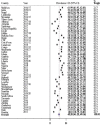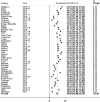Prevalence and factors associated with anemia in women of reproductive age across low- and middle-income countries based on national data
- PMID: 37990069
- PMCID: PMC10663544
- DOI: 10.1038/s41598-023-46739-z
Prevalence and factors associated with anemia in women of reproductive age across low- and middle-income countries based on national data
Abstract
Anemia is a global threat among women of reproductive age (WRA), or 15-49 years old women, both in developed and developing countries. Prevalence of anemia in WRA is higher by fourfold in developing countries, based on extensive studies and surveys conducted by WHO and UNICEF. However, there is limited studies that conducted pooled analysis of anemia prevalence in low resource countries. This study aimed to assess the prevalence and factors associated with anemia among women of reproductive age in low- and middle-income countries (LMICs). This study used secondary data from the Demographic and Health Survey (DHS) in 46 low- and middle-income countries during 2010-2021. Descriptive statistics of proportions between pregnant and non-pregnant mothers were assessed. Multilevel binary logistic regression was used to test the factors associated with anemia among women of reproductive age. A total of 881,148 women of childbearing age in LMICs were included. This study found a high prevalence of 45.20% (95% CI 41.21, 49.16) of anemia was observed in among pregnant women and 39.52% (95% CI 33.88, 45.15) anemia was observed in non-pregnant women. Educational status, wealth status, family size, media exposure, and residence were common factors significantly associated with anemia in both pregnant and non-pregnant women. The high global burden of anemia in LMICs continues to underline the need for unusual approaches and target interventions on an individual basis. Global commitment and movement to reduce the prevalence of anemia need to be revisited and redesigned for current circumstances.
© 2023. The Author(s).
Conflict of interest statement
The authors declare no competing interests.
Figures
Similar articles
-
An unacceptably high burden of anaemia and it's predictors among young women (15-24 years) in low and middle income countries; set back to SDG progress.BMC Public Health. 2023 Jul 5;23(1):1292. doi: 10.1186/s12889-023-16187-5. BMC Public Health. 2023. PMID: 37407912 Free PMC article.
-
Tobacco Use Among 1 310 716 Women of Reproductive age (15-49 Years) in 42 Low- and Middle-Income Countries: Secondary Data Analysis From the 2010-2016 Demographic and Health Surveys.Nicotine Tob Res. 2021 Nov 5;23(12):2019-2027. doi: 10.1093/ntr/ntab131. Nicotine Tob Res. 2021. PMID: 34291296 Free PMC article.
-
Prevalence and Risk Factors for Iron Deficiency Anemia among Children under Five and Women of Reproductive Age in Pakistan: Findings from the National Nutrition Survey 2018.Nutrients. 2023 Jul 28;15(15):3361. doi: 10.3390/nu15153361. Nutrients. 2023. PMID: 37571298 Free PMC article.
-
Anemia among Women of Reproductive Age: An Overview of Global Burden, Trends, Determinants, and Drivers of Progress in Low- and Middle-Income Countries.Nutrients. 2021 Aug 10;13(8):2745. doi: 10.3390/nu13082745. Nutrients. 2021. PMID: 34444903 Free PMC article. Review.
-
Role of iron in the reduction of anemia among women of reproductive age in low-middle income countries: insights from systematic review and meta-analysis.BMC Womens Health. 2023 Apr 17;23(1):184. doi: 10.1186/s12905-023-02291-6. BMC Womens Health. 2023. PMID: 37069552 Free PMC article.
Cited by
-
Modifiable risk factors for anemia among women of childbearing age in sub-saharan Africa (2015-2023).BMC Public Health. 2025 Jan 22;25(1):267. doi: 10.1186/s12889-025-21427-x. BMC Public Health. 2025. PMID: 39844125 Free PMC article.
-
Dietary diversity insufficiently explains differences in prevalence of anaemia in pregnancy across regions in Nigeria: A secondary analysis of Demographic and Health Survey 2018.PLOS Glob Public Health. 2025 May 29;5(5):e0004540. doi: 10.1371/journal.pgph.0004540. eCollection 2025. PLOS Glob Public Health. 2025. PMID: 40440411 Free PMC article.
-
Magnitude and determinants of anemia among patients at Garbo Primary Hospital, Somali Region of Ethiopia.Sci Rep. 2025 Aug 1;15(1):28179. doi: 10.1038/s41598-025-07914-6. Sci Rep. 2025. PMID: 40750963 Free PMC article.
-
Iron deficiency anemia in pregnancy and related complications with specific insight in Rivers State, Nigeria: a narrative review.Ann Med Surg (Lond). 2025 Apr 2;87(6):3435-3444. doi: 10.1097/MS9.0000000000003224. eCollection 2025 Jun. Ann Med Surg (Lond). 2025. PMID: 40486642 Free PMC article. Review.
-
Prevalence and factors associated with anemia among HIV-infected women in sub-saharan Africa: a multilevel analysis of 18 countries.BMC Public Health. 2024 Aug 16;24(1):2236. doi: 10.1186/s12889-024-19758-2. BMC Public Health. 2024. PMID: 39152367 Free PMC article.
References
-
- WHO . Anaemia. An Overview. WHO; 2021.
-
- Diana, P. & Hikmah, N. Factors causing anemia in women of reproductive age. In International Conference Health, Science And Technology (ICOHETECH) 34–35 (2021).
MeSH terms
LinkOut - more resources
Full Text Sources
Medical



